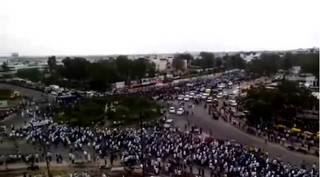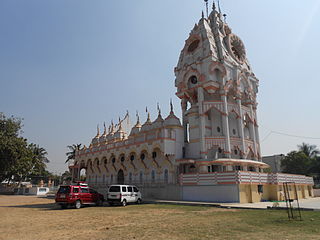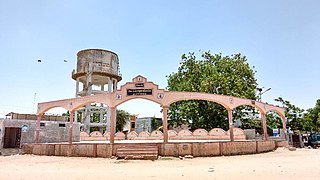
Manthan, also released under the translated title The Churning, is a 1976 Hindi film directed by Shyam Benegal, inspired by the pioneering milk cooperative movement of Verghese Kurien, and is written jointly by him and Vijay Tendulkar. It is set amidst the backdrop of the White Revolution of India. Aside from the great measurable success that this project was, it also demonstrated the power of "collective might" as it was entirely crowdfunded by 500,000 farmers who donated Rs. 2 each. Manthan is the first crowdfunded Indian film.
Modh is an Indian caste. Its members are people who use the name and originate from Modhera in Gujarat.

Patidar is an Indian landlord and agrarian caste found mostly in Gujarat but also in at least 22 other states of India. The community comprises at multiple subcastes, most prominently the Levas and Kadvas. They form one of the dominant castes in Gujarat. The title of Patidar originally conferred to the land owning aristocratic class of Gujarati Kunbis, however it was later applied en masses to the entirety of the peasant population who lay claim to a land owning identity, partly as a result of land reforms during the British Raj.
Desai is an Indian administrative, princely or honorary title and surname.

Borsad is a city and a municipality in Anand district in the state of Gujarat, India. It is located around 17 km from Anand. It is surrounded by the fertile Charotar region which largely produces tobacco, bananas, cotton, barley and other agricultural crops. Borsad was the seat of the Borsad satyagraha in 1922–23.
The Gujarati people or Gujaratis, are an Indo-Aryan ethnolinguistic group who reside in or can trace their ancestry or heritage to the present-day western Indian state of Gujarat. They primarily speak Gujarati, an Indo-Aryan language. While Gujaratis mainly inhabit Gujarat, they have a diaspora worldwide. Gujaratis in India and the diaspora are prominent entrepreneurs and industrialists and maintain high levels of social capital. Many notable independence activists were Gujarati, including Gandhi, Patel, and Jinnah, as well as the current Prime Minister of India, Narendra Modi.
Sunni Vahoras or Sunni Bohras, are a community from the state of Gujarat in India. Sharing many cultural similarities with the Dawoodi Bohras, they are often confused with that community. The community in Pakistan uses the surname "Vohra" and not Bohra and are commonly known as Sunni Vohras. A few families use the slightly different spelling of "Vora" or "Vohra" as their surname. Another common surname is Patel.
Hadecha is a village in Chitalwana Tehsil in Chitalwana sub-division in Jalore district of Indian state of Rajasthan. Hadecha is about 15 km from SanchoreHadecha is an important town in Sanchore Tehsil.
Satpanth is a Sanskrit term used initially by Nizari Isma'ilis and Ismaili Sufis to identify their faith formed over 700 years ago by Pir Sadardin. Although the term is today used mainly by its subgroup formed in the 15th century by his grandson Pir Imam Shah which itself consists of various sub-sects, and differs from the mainstream Nizari Khojas in that they reject the Aga Khan as their leader and are known more commonly as Imamshahi. Uniquely, the term Satpanth has been historically used by Ismailis that claim to be Muslim, as well as by adherents of subgroups that claim to be Hindus. There are villages in Gujarat which are totally Satpanthi such as Pirana near Ahmedabad where Imam Shah is buried. Satpanthi dargahs are known to be venerated with a stark contrast in the devotees, with outward Muslims who may wear a hijab, and outward Hindus wearing traditional garb such as the sari.

Mota is a village in Gujarat, India, 5 km north of Bardoli and 32 km east of Surat.
Rangilu Lavarpur' is a village in Gandhinagar district in the Indian state of Gujarat.

The Sahariya are a community found in the Bundelkhand region of North India, which is administered by the states of Madhya Pradesh and Uttar Pradesh. They are also known as Rawat, Banrawat, Banrakha and Soarain.

The Pateliya, or Patelia or Patel is a landowning Subcaste of Koli caste found in the Indian states of Gujarat. During the British Raj in India, Patelia Kolis served as tax collectors and administrators. The name Patelia comes from a word meaning village chief. Many Patelia Kolis also went into business and commerce during the Raj period. Patelia Kolis are part of Talapada Kolis of Gujarat.
The Nayak are a Hindu caste; also some Nayak are Punjabi found in India and Pakistan. Mainly Nayak follows Hindu. According to Vinay Krishin Gidwani, the Nayaks claim that they were, historically, Brahmins.

Kherva is a village in the Mehsana District, Gujarat, India, situated on State Highway 73 between Gandhinagar and Mehsana. It borders the following villages: Devarasan, Kadavasan, Mulsan, Jagudan, Sanganpur, Punasan, Hebuva, Udalpur, Gunjala, Dharusan, and Dhamnava.
Varad is a village in Gujarat state, India, 5 km north of Bardoli.

The Koraga are a tribal community found mainly in the Dakshina Kannada, Udupi districts of Karnataka and the Kasaragod district of Kerala, south India. These areas in Karnataka, are altogether often referred to as Tulunaad, which roughly corresponds to the boundaries of the erstwhile South Canara district. They are also found in small numbers in adjoining districts of Uttara Kannada, Shimoga and Kodagu. The Koraga are classified by the Government of India as a Scheduled Tribe.
KHAM stands for Koli Kshatriya, Harijan, Adivasi and Muslim. Here Kshatriya is taken to include the Kolis. In the KHAM combine, Kolis were the largest caste represented at different levels of politics, and Madhavsinh Solanki increased the reservation quota for Other Backward Classes in Gujarat. The theory was propounded by Madhavsinh Solanki in 1980s in Gujarat to create vote bank for Indian National Congress and prepared by Jhinabhai Darji. Using the formula, Congress was able to capture 149 seats in the 182-member Assembly. However the formula alienated Patels permanently from Congress. during the Kham alliance, castes such as Bania, Patidar and Brahmins lost their importance in the state, so they propounded the Anti reservation agitation in 1981 and 1985 in Gujarat to get rid of the power of OBC castes.
Vatadra (Vatadara) is one of the larger villages of Cambay county of Anand district in Gujarat state (India). It is a gram panchayat village. Because of its size, it is the only village in its gram panchayat. Prior to 1997, Vatadra was located in Kaira District.

Makaji Meghpar is a village and former chiefdom of Hardhrol Jadeja chieftains in the Jamnagar district of Gujarat, India. It was founded in 1754 by Makanji Jadeja of Dhrol State. Gujarati writer Harilal Upadhyay was from the village. The people are mainly Jadeja Rajputs with some Brahmins, Patels and Dalits.








